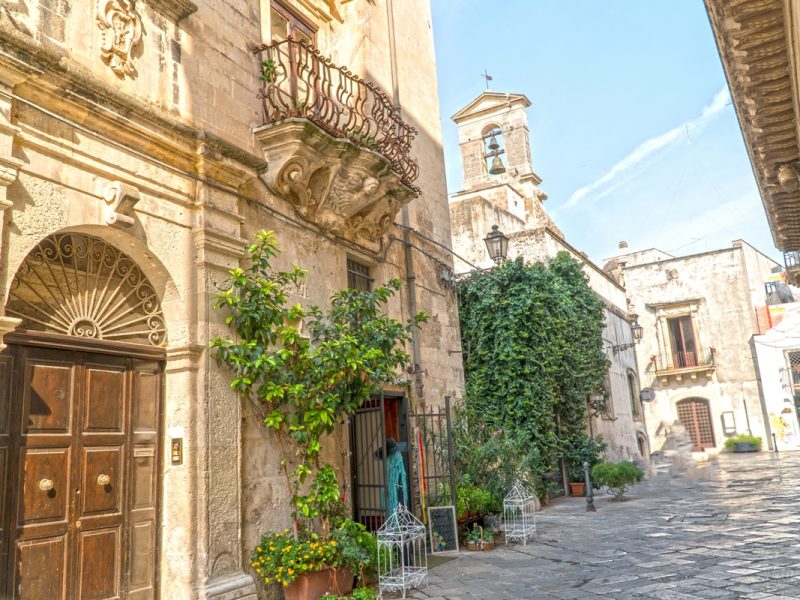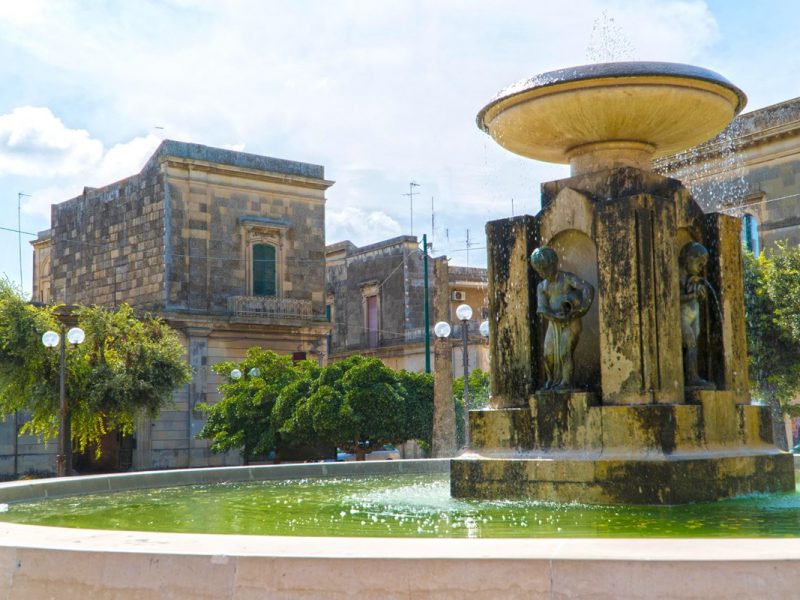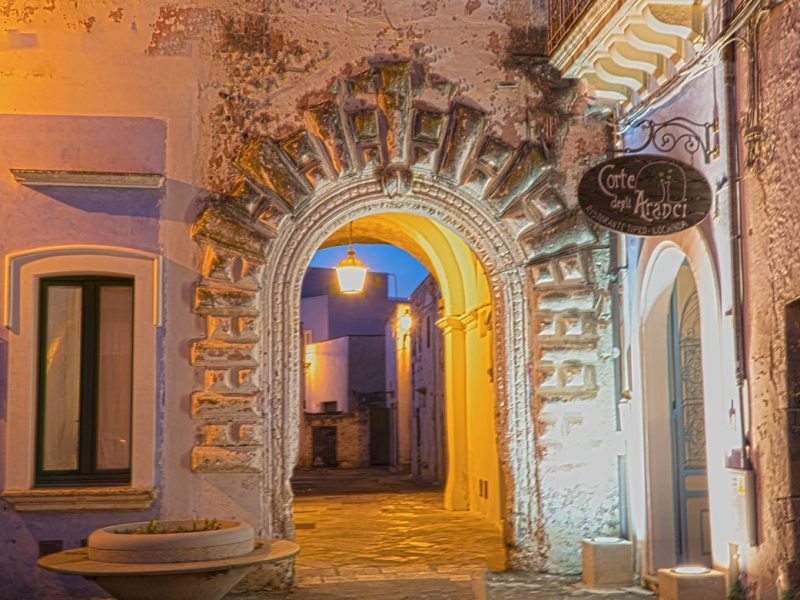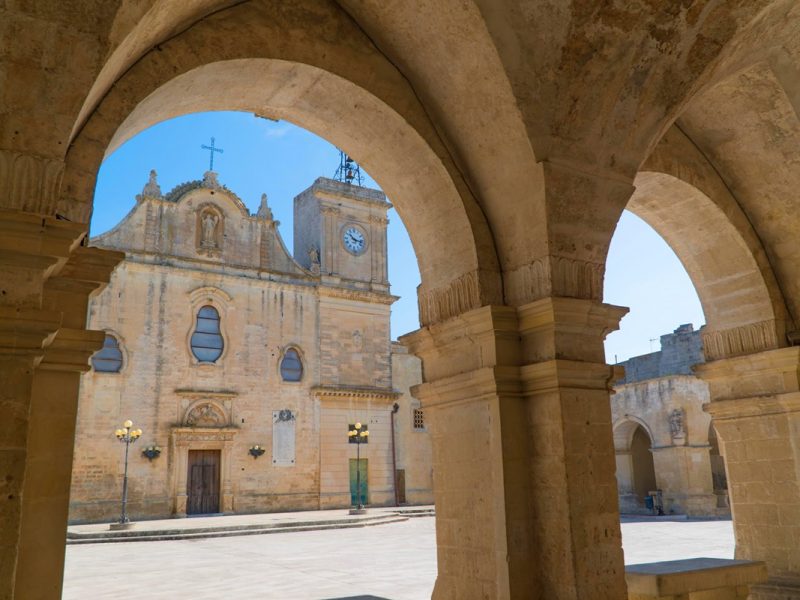The Borgo of Nardò
Have you ever been to Heaven ? In Nardò, you will feel like you’ve arrived: descend the steep, cypress-lined path through the pine forest and that first glimpse of the bay of Porto Selvaggio opens up before you…an enchanted natural paradise, just a few kilometers from one of the most beautiful borghi in Italy.
The largest city in the Province of Lecce, Nardò, Neretum in Latin, is the generous, tireless benefactor of a territory with the golden sands of Sant’Isadora, coasts woven into the rocky cliffs, Baroque churches and palaces and the imposing castle, which, like an ancient patriarch, opens the formidable gates of the historical center and welcomes you in.
Nardò has a long, rich history, and every era has left its mark, from the Jewish population after WWII, to the revolutionaries before the unification of Italy, from the domination of the Roman Empire, all the way back to the ancient, fortified coastal tower of Uluzzu, where it all began. It’s all here in Nardò, the living, breathing history of Salento, of Italy, and of Europe.
The fascination of Nardò captivates the heart and mind: if you haven’t been, you want to visit, and if you have, you want to return.
Santa Maria al Bagno
The cobalt blue of the sea makes it an irresistible destination for the summer holidays, but Santa Maria al Bagno is much, much more. First and foremost, it is the most ancient settlement of Nardò, where important examples of prehistoric civilization have been found in its Grotta del Cervo (the Deer Cave). Later, the rocky coastal cliffs favored the settlement of a little fishing village, which flourished peacefully until the arrival of the Romans, who transformed Santa Maria al Bagno into a port and a thermal spa.
Today, this little borgo passes most of the winter in repose, waiting for the summer season, when the splendid combination of sun and sea attracts a wave of holiday goers that electrifies the entire coast.
Santa Caterina
The Tower of Santa Caterina is called Tower of the Damned, due to the legend of a young virgin who threw herself off to escape the advances of Guercio di Puglia, the Duke of Nardò. Another legend recounts the miraculous appearance of the Madonna to a group of fishermen who were seeking refuge in the tower during a storm. Legendary and historic, the Tower of Santa Caterina watches over her rugged hillside and her bay of inlets and fragrant green pine forests. Built during the Angevin domination, after four centuries it has conserved its imposing yet soothing aspect as the tireless custodian of its vibrant territory, and is completely different from the other coastal towers in the area. On the ground floor you can still see the stalls for animals and on the upper floor, the vestiges of an apartment, complete with fireplace.
The Tower of Santa Maria dall’Alto is set on the hill in the Natural Park of Porto Selvaggio.
In 2008, the attraction of nature, history, marvelous villas and the brilliant blue of the sea all combined to win Santa Caterina the title of fifth most beautiful seaside town in Italy.
Boncore
Boncore was once a part of the extended territory of Arneo, so large that its borders touched those of Lecce, Brindisi and Taranto. The Arneo was theatre to an important social reform, the first to challenge the omnipotent power of the landowners. The journalist Vittorio Bodini recounts that, given the vast expanse of land they had to travel each day to their fields, nothing was more important to the farmers of this territory than their bicycles. When the landowners confiscated all the farmers’ bicycles in a punitive show of strength, condemning them to endless hours on foot and brutally cold nights far from home, the field workers rose up in protest against the landowners, and their victory brought about the first reform towards civil justice: the Stralcio reform. A small part of the Arneo has become Boncore, a part of the Nardò district.
Sant’Isidoro
Sant’Isidoro is the most recent segment of Nardò. It developed around the Torre of Sant’Isadoro and is graced by golden sands and crystal clear sea, attracting numerous visitors during the summer season.
History
Nardò was founded by the Messapians in 460 B.C., and has been a land of history and legend all through the centuries.
In the third century, the city was reabsorbed into the Roman Empire, and from then on, its history has been intertwined with the various populations who came to dominate and inhabit its territory.
When the feudal territory of Nardò passed into the hands of the Acquaviva family in 1497, it became a Dukedom. A passionate patron of the arts, Duke Bellisario Acquaviva brought flourishing culture and art to the city. Over the centuries, Nardò offered refuge and home to numerous monastic orders, and thanks to which we have an immense patrimony of Baroque art and architecture, with churches and convents shining like gems throughout the streets of the city.
When the Kingdom of Naples passed into Spanish hands, the fiscal pressure levied by the Bourbons brought on civic uprising and cruel oppression.
Feudal domination ceased to exist in 1806, but Nardò continued to be subjected to an authoritarian power, the landowners. Two revolutions took place in attempts to free the population from their yoke, the most recent being the Arneo, which concluded with the drafting of the Stralcio reform, the first concrete judicial act against the omnipotence of landowners over the population.
Nardò is a land of agriculture and rebellion, characteristics woven into the social fabric of the city, which to this day continues in its undaunted opposition to the scourge of exploitation.
Uluzzu
Uluzzu is a sharp-edged word that buzzes like a distant echo from an archaic dialect. In fact, the word comes from the Paleolithic period Uluzziano; indeed, the craggy inlets of this bay were home to the very first Homo sapiens in Europe, traces of which have been found in the human remains and cave paintings dating back to between 80,000 B.C. to 100 B.C.
Castello Acquaviva
Duke Giulio Antonio Acquaviva gave two important contributions: leading the Aragonese army to liberate Otranto from the invading Turks, and the construction the Castle of Nardò.
Its crenellated walls and battlements are the symbol of a castle constructed to defend the population, which in the 1800’s, then passed into the hands of the Personè dynasty, who transformed it into an elegant noble home, introducing Baroque elements such as the embossed walls and cornices sculpted with the faces of humans, animals and strange demons.
The castle also had a moat, a small part of which remains next to the botanical garden.
Today, this marvel serves as the City Hall. In the Council Chambers you can admire three artistically important paintings of depicting Nardò in the past: the defensive walls in their entirety, the ancient churches and bell towers that were destroyed long ago, the marvelous clock tower and an original emblem of the city.
Basilica Cattedrale di Santa Maria dell’Assunta
Nardò is a triumph of Baroque architecture, starting from Piazza Salandra, proceeding along to the churches and monasteries of the historical center. The façade of the Basilica Cathedral is also Baroque, but its hidden origins are much more ancient, conserving within its walls the remains of an ancient abbey belonging to the Basilian monks, the first monastic order to reach Neretum.
The Cathedral we see today is an interweaving of styles and epochs, having undergone numerous restoration and restyling interventions due to the ravages of adverse weather conditions, as well as the numerous earthquakes which weakened the structure. When the Benedictine monks arrived, the Cathedral had been eroded by atmospheric damage, and they wisely restored it with Carparo, a more resilient stone. The Normans, in turn, carried out modifications, and also restored the bell tower.
The facade seems foreign to the rest of the church, being the only remaining Baroque element, as the Baroque roof was destroyed in an eighteenth century renovation.
The Cathedral of Nardò is the proud custodian of important works by southern Italian painters, but its true pride and joy is the black maple-wood crucifix with Christ on the cross, adored by the citizens of Nardò because of the legend recounting that, when the invading Turks were sacking the city, as they were dragging the crucifix into the piazza to burn it, they cut off one of Christ’s fingers and it began to bleed.
The Osanna Temple
The Osanna is an extremely unusual monument, the exact significance of which has yet to be established. It is a small octogonal temple in oriental style, with a central column placed in the center, topped with a spire.
It is thought to symbolize the power of Christianity imprisoning and blocking the other religions, and it is in fact highly probable that the central column is either a pagan artifact or a prehistoric stone object of worship called a “menhir”.
The Regional Natural Park of Porto Selvaggio and Palude del Capitano
A steep and winding path through the shady Aleppo Pine woods leads to one of the most beautiful bays in southern Italy. As you walk through the fragrant pines, you suddenly find yourself before a breathtaking view: a turquoise bay surrounded by lush green trees and gently sloping rock formations, where, after a dive into the toning crystalline sea that purifies the body and the senses, you will emerge invigorated. We are in the Natural Park of Porto Selvaggio, which was founded in 1980 and later enlarged in 2006, its territory reaching the area of the “Palude del Capitano”.
The park has over one thousand acres of virgin wilderness inlaid with artfully landscaped areas, creating an ecosystem hosting original Mediterranean flora as well as pine forests planted in the fifties, with beautiful artificial caves as well as natural caves that recount the ancient history of mankind. Two of these caves are internationally important paleontological sites, the Grotta del Cavallo (The Horse Cave), and the Uluzzu Cave, both home to the first Homo sapiens in Europe, the Uluzziano Man.
A little further along, we find traces of an ancient Neolithic necropolis unlike anything else in the world, which today is still full of mystery and interesting particularities, such as the prehistoric human remains buried under the Neolithic “Menhir” stone monuments.
The Palude del Capitano (The Captain’s Marsh) is the desert island we all dream of, a land of enchantment, with a fresh water spring flowing out from the rocks, and salt water seeping up through the earth. A place where time has stopped and the modern world is kept at bay, as an enterprising sea captain must have thought when he built his little house there, to live in peace and quiet, passing the hours gazing at the pond, admiring the marine life and rare plants cohabitating the island’s unique ecosystem.
Whether you are an adventure-seeker or simply long for the solace of nature, if you love diving from the rocks or prefer swimming at the beach, the challenge of trekking or the relaxation of sunbathing on golden sands, paleontology or archeological scuba diving, the Natural Park of Porto Selvaggio has everything you could desire, and much more.
Ville delle Cenate, the Villas of Cenate
The mansions, or villas, of Cenate are halfway between the historical center of Nardò and the limpid blue sea of Santa Caterina. Along the road that connects these two points, there is an extraordinary, enchanted world, a jubilation of Liberty and Baroque architecture exalted by Moorish and Neo-Gothic accents and details, created by the most important architects of the period: the Villas of Cenate. The villas were constructed between the 1700’s and 1900, and are framed by white private roads and surrounded by fig trees and the pungent, refreshing scents of Mediterranean foliage. They reflect the discriminating taste of the upper middle class of the day: with delightful gardens full of exotic plants and neo-classical statues. Via Taverna is the name of the road that connects the southernmost tip of Salento, Santa Maria di Leuca, to Taranto in the north. It was named after a villa on this road, Villa Taverna, which was originally a hostel and a place to rest horses, built in the 1400’s, making it the most ancient of all the villas in the architectural complex. The existing villa was built in 1780, around the ancient nucleus, testimony of which can still be seen in the horse-tethering poles remaining in the garden. It is a villa of sober elegance, graced by a large arched entryway and Baroque balconies, framed by a high wall protecting its borders. Another beautiful historical home in the complex is the “Cinata del Monsignore”, built as a summer residence for the clergy, commissioned by the Bishop Petrucelli in 1755. Its construction was completed in 1838, under the direction of the acting bishop at that time, Bishop Lettieri, who chose to impose two dominant architectural styles: Baroque and Neoclassical, with magnificent results.
All the homes in Ville Cenate exude a timeless fascination, but none of these wonders matches breathtaking beauty of the extraordinary Villa Maria Cristina Personè. Built between 1920 and 1930, the entire structure is a delicate interweaving of Baroque and Moorish/Arabic architectural styles, with superb oriental archways, sinuous lines, gorgeous decorative elements and monumental staircases. It is a magical world where you can imagine elegant summer parties on the sumptuous patio, illuminated by candlelight and the glittering evening wear of the refined guests. Toward the end of the Second World War, this villa was appropriated by the occupying German forces, and you can still see the indentations of their nailed boots in the floors.
A little farther along, Villa Mucci, was used as a hospital during the both World Wars, and later gave refuge to a group Jewish survivors of the Nazi concentration camps. This particular villa, so full of historical importance, now lies empty and unprotected against the ravages of time.
The road along the Ville Cenate is one of the most beautiful parts of Salento, so, on your way to the sea, stop for a moment to admire these miraculous architectural creations, their captivating grace will leave you spellbound.
Nardò, a Jewish Memorial
Exhausted to the bone, their souls wracked in anguish, this must be how the Jewish survivors of the atrocities of the concentration camps felt. Between 1943 and 1945, some of the survivors found hospitality in Nardò and the neighboring Santa Maria al Bagno. In fact, the municipality built a Jewish quarter especially for them, complete with a Kibbutz and a synagogue. Exploring the dusty and long abandoned buildings, you can still admire the murals created by Zivi Miller in those first years following the holocaust, thanks to the foundation of the “Museo della Memoria e dell’Accoglienza” (Memorial Museum of Hospitality), which has collected the testimonials and material of that period, made available by the Associazione Pro Murales Ebraici.
To this regard, in recognition of the generous altruism of its citizens, in 2005 the City of Nardò was awarded the Medal of Civil Valor by the President of the Italian Republic, Carlo Azeglio Ciampi.
Nardò Technical Center- Porsche Engineering
A top secret location, surrounded by ten thousand trees and a maximum security protocol imposed on the employees and the few guests fortunate enough to be allowed access, with no photos of any kind permitted: it’s no wonder that not many people know about the Nardò Technical Center, the state-of-the-art race track used to test high speed cars.
Built in 1975 by Fiat during the company’s heyday, the center was acquired by Porsche in 2012. It is an enormous circular track with a diameter of four kilometers, and takes up an area of seven hundred acres. Inside there are twenty test tracks, fully equipped to simulate every type of driving condition: straight tracks, hairpin curves, uphill tracks, downhill tracks, everything necessary to guarantee complete vehicle evaluation. This, and the fact that the facility is constantly updated with the latest technological advancements, offering the possibility of reproducing any type of atmospheric condition on any given day of the year, has positioned the Nardò Technical Center as one of the most important testing tracks in the world. In the realm of high velocity, this testing circuit is known for facilitating record-breaking performances which would have been impossible to accomplish elsewhere. To name a few: in 1979, Mercedes Benz was able to reach over four hundred km per hour and in 2002, Volkswagon beat the 24 hour record for distance and velocity, covering 7,740.576 kilometers in twenty-four hours, at a velocity of 322,891 km per hour.
Head-spinning world-class results just a short distance from the ancient “borghi” of Salento, fascinating for thrill-seekers but surely not for the weak-hearted!
Daniele Greco
Daniele Greco was born in Nardo, March 1, 1989. It is a promise of athletics, specialized in triple jump.
In 2009, just twenty years old, he became a champion at the under 23 European Championships in Kaunas and in 2013 he reconfirmed his position at the European Indoor Championships in Gothenburg and at the Mediterranean Games in Mersin.
_________________________________
Do you know other famous people of this Borgo? Contact Us!
Do you know typical recipes of this Borgo? Contact Us!

 Italiano
Italiano
 Deutsch
Deutsch































